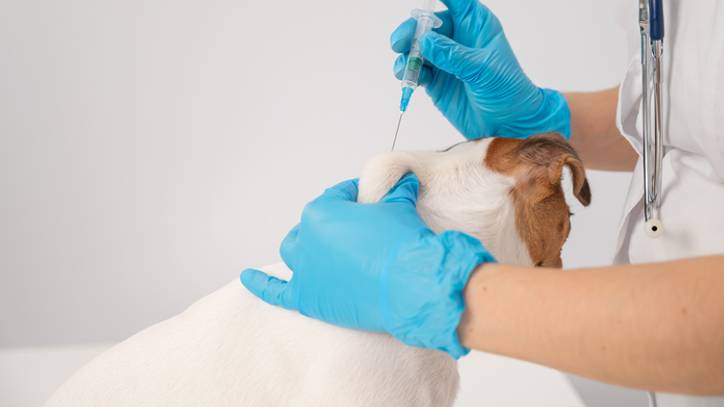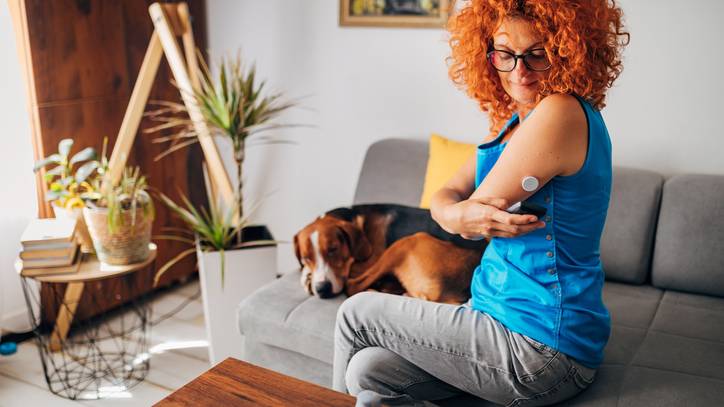How to give a dog insulin: A vet's guide
Giving a dog insulin is easier than you think! Our vet explains below…

As a caring pet owner, it's only natural you may worry about giving your dog insulin, but it’s much easier than it sounds.
If your dog has been diagnosed with diabetes, you’ll probably be wondering how you can treat dog diabetes and how to manage it from home.
Dogs suffer from Type 1 diabetes, which means that they have insufficient insulin production. This means that the mainstay treatment of dog diabetes is with insulin.
Read on to find out more about types of insulin treatment, storing insulin, and how to give your dog insulin, as well as home care tips.
- Best diabetic dog treats: 7 snacks to help manage diabetes
- Diabetes mellitus in dogs: A vet's guide
- Diabetes insipidus in dogs: A vet's guide
What is diabetes in dogs?
Diabetes is a disease where the body has too much glucose in the blood (high blood sugar). In normal dogs, insulin removes glucose from the blood and moves it into storage in the liver and in fat.
In diabetic dogs, insufficient insulin means the glucose remains in the blood and reaches dangerously high levels
Managing dogs with diabetes
The mainstay of diabetes treatment in dogs is insulin. This needs to be given twice daily, by injection.
However, there are also some lifestyle changes that you can make to help manage your diabetic dog:
Consistent diet
Firstly, your dog’s diet. It doesn’t hugely matter what your dog is fed, but it’s very important that they’re fed a consistent amount, every day. This is because the amount of insulin they receive will be worked out for them as an individual, taking into account their blood sugar rise after eating.
If they eat different amounts or different foods each day, it’s impossible to work out their insulin dose correctly and they’ll be at risk of under-dosing or over-dosing, both of which are dangerous.
Your vet will ask you to feed your dog a consistent diet – the same brand, flavour, and amount, at predictable times each day. Unfortunately, that also means no treats – although your vet might OK one or two small treats for diabetic dogs as long as they’re given at the same time every day.
Consistent exercise
Similarly, exercise should be consistent day-to-day. Exercise uses energy and mobilises blood sugar so it has an impact on how much insulin a dog needs.
Keeping your dog’s walks at the same time and for the same intensity and length each day might seem boring, but it will help you get their blood sugar under control much faster and more reliably too.
Spaying
Another important consideration if your female dog is entire is to spay them. Their hormones will play havoc with their insulin doses every time they come into season.
Remember, these lifestyle changes only help you stabilise your dog – they won’t be enough to treat canine diabetes on their own.

Types of insulin treatment for dogs
While there are a few different types of insulin treatment for dogs, injectable insulin is by far the most commonly used, as it’s the most reliable. Oral insulin is sometimes used in humans, but this doesn’t work reliably in dogs and is not recommended.
There are several different types of injectable insulin. The most commonly used dog insulin is ‘Lente’ insulin, an intermediate-acting insulin that is injected twice daily, exactly 12 hours apart.
‘Protamine zinc insulin’ (PZI) is another type of injectable insulin. While it’s usually used in cats, it can also be used in dogs and is slightly longer acting than lente insulin, meaning it only needs to be given once daily in some cases.
Canine insulin is usually provided in a multi-dose bottle, with small syringes to draw it up. However, some people find an insulin pen easier. This allows you to draw up the insulin automatically, which is great for people with arthritis, with improved dosing accuracy with small doses.
Is there an alternative to insulin injections for dogs?
Unfortunately, it’s not possible to stabilise a diabetic dog without insulin injections, so there is no alternative. Untreated dogs, or poorly treated dogs, will quickly become extremely ill.
If insulin injections are impossible, a good quality of life cannot be achieved and euthanasia is sometimes the only option. In fact, a recent survey suggested that 1 in 10 dogs with diabetes will be euthanised when they are diagnosed.
Can I use human insulin for my dog?
In almost all cases, human insulin is not the right sort of insulin and won’t be effective for dog diabetes.
Using the wrong type of insulin can be extremely dangerous, as human insulin is at a different concentration to dog insulin, meaning over-dosing is easy.
However, very occasionally specialists may use human insulin when canine insulin isn’t working for some reason. Legally, canine options have to have been explored first. And since canine options are much more likely to work for the vast majority of dogs, they’re definitely the better bet.

How much does it cost to put a dog on insulin?
Dog diabetes can be expensive to treat. The insulin itself is expensive, but your vet will also need to do regular tests to make sure the dose is right for your dog. These tests quickly add up, especially early on when every dose change needs to be followed by testing every couple of weeks.
While the exact cost is going to depend on your dog’s dose, dog insulin costs £30-50 per vial, meaning the drug alone costs £50-90 ($60-100) per month to treat a diabetic dog.
Dog insulin is not available over the counter, so you need a prescription to buy dog insulin. Instead of buying canine insulin from your vet, you can ask them to write you a prescription so you can buy it elsewhere. They can charge a small amount for this written prescription, so it may not work out less expensive.
Tips for storing dog insulin
It’s very important that dog insulin is stored correctly, as incorrect storage can cause it to become ineffective. Most insulin needs to be stored in the fridge at a constant temperature. Don’t store it in the door, as this can be warmer than the rest of the fridge and repeatedly warms and cools as you open the fridge.
Instead, inside a Tupperware in the middle shelf of the fridge is a good place. Remember to regularly check your fridge for ice as you don’t want to freeze your insulin. Only take your dog’s insulin out of the fridge to draw up their dose – return the remainder to the fridge immediately.
How to give insulin to your dog
- Remove the insulin from the fridge and gently turn the vial upside down a few times to mix. Do not shake, as this can damage the insulin molecules and stop them from working.
- Clean the top of the vial with an alcohol wipe, then remove cap from needle and insert needle through the rubber bung.
- Turn vial upside down so that syringe is beneath, and draw up the dose of insulin required for your dog. Check that no air bubbles are in the syringe, as this will affect the dose. Sometimes it helps to draw up more insulin than you need, then inject the spare back into the bottle, as this will help to get rid of any air bubbles.
- Using your non-dominant hand, pick up a roll of skin near your dog’s neck. This roll should form a ‘tent’ with a triangle at the end, and you will want to aim the needle into the tent at the triangle in order to inject under the skin.
- Hold the syringe in your dominant hand, and, with your index finger, poke the roll of skin where you want to inject. This should be at the end of the roll of skin, with your needle parallel to the roll – if you inject across the roll (with the needle perpendicular) you might go through the skin and inject the insulin into the air on the other side!
- Once you’re happy with where you’re injecting, insert the needle. This is best done quickly and without hesitation. Depress the plunger to inject the insulin under the skin.
- Withdraw the needle and release the skin.
- Do not put the cap back on the needle. Place the used syringe and needle into a sharps container, which you should have nearby.
How to keep a dog calm during insulin injections
The insulin needle is very tiny, and most dogs won’t even notice it. Keeping calm yourself is important, as dogs can pick up on your anxiety and tense up, making injection harder (and more painful).
To keep your dog calm while injecting insulin, you can try to distract them. A good option is to give a small amount of food on a lick mat. However, remember to keep the amount of food the same each day in order to help their blood sugar.
Alternatively, train your dog to accept the injection by making the insulin injection part of a predictable routine – they eat their breakfast, they get their injection, then they get a treat.
Some people even train their dogs to have injections as puppies by practicing lifting the skin on the back of the neck and pinching slightly, then giving a treat. This helps for annual vaccinations as well as in case your dog needs insulin!

Symptoms of low blood sugar in dogs
If you give too much insulin, your dog’s dose is incorrect, or your dog’s insulin requirements suddenly drop, your dog may get low blood sugar, or hypoglycaemia.
This is an extremely dangerous situation and you will need to act fast. The signs of low blood sugar in dogs include:
- Hunger (early sign) then loss of appetite
- Restlessness
- Wobbliness
- Lethargy
- Confusion
- Shivering
- Seizures
If you see any of these symptoms of low blood sugar in your dog you should act immediately.
Spread a high-sugar solution like jam onto their gums and call your veterinarian for further instructions. If your usual vet is not open, call the nearest open veterinary surgery immediately.
Summary
Insulin is the mainstay of diabetes treatment in dogs. With the correct dose of insulin, correctly given, the diabetes can be well managed and your dog may live for many years.
If you are ever unsure about how to give your dog insulin, you should contact your vet who will arrange a demonstration.
PetsRadar Newsletter
Get the best advice, tips and top tech for your beloved Pets
After graduating as a vet from the University of Nottingham, Dr Joanna Woodnutt went on to practice companion animal medicine in the Midlands. Since then, she has also written for countless online and print publications and is a regular contributor for Edition Dog Magazine.

